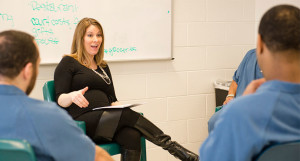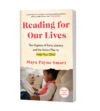Sarah Scarbrough exudes passion and pragmatism. She’s internal program director for the Richmond City Justice Center in Virginia (formerly the Richmond City Jail), and she’s serious about giving offenders another chance. To help these most disadvantaged, dismissed members of our society, Scarbrough takes a holistic approach in partnership with other agencies and the community at large.
I saw Scarbrough in action in February, when I participated in an event designed to help volunteers and philanthropists understand the connection between incarceration and homelessness.
At the Justice Center, our group heard inmates describe the effectiveness of Scarbrough’s rehabilitation program and lament their prospects for continuing progress after being released. The average number of incarcerations is 7.7 among the men and women in the RCJC Program that Scarbrough oversees.
“Somebody could have the utmost motivation while in jail, in the program, but if they’re released and they are homeless, or they don’t have the proper preparation to be released, they’re going to revert back to the old ways,” Scarbrough says.
“You’re homeless. Where do you go? You’ve burned all your bridges. You have no family or friends to call. You’re back on the same corner, doing the same thing, with the same people that you were doing it with prior to [incarceration]. You go back to survival mode, that’s what was happening. So we’ve added a huge reentry component to really try to make sure that everyone has a plan in place for success upon release.”
We all left the jail with deeper insight into the complexities of offender reentry, as well as our collective stake in helping people get a fresh start. In response, members of our group set up an endowed Housing Assistance Fund at the Community Foundation serving greater Richmond and central Virginia. Donations to the fund help men and women secure transitional and permanent housing upon release.

As Scarbrough puts it, “95 percent of people who are incarcerated will come back to our community. So the question is, Do you want them to be better criminals or better citizens?”
During two phone interviews in the months since my visit, I asked Scarbrough to share a few more details about how she pursues the latter.
When you first began, you were working in the city jail. How did you feel entering the jail for the first time?
The first time I went in, I was terrified. I started back in the jail probably about eight years ago, when I was conducting dissertation research for my PhD at Virginia Commonwealth University. The old jail was a just a dirty, dingy, dark, dungeon-like place with people on the other side of bars screaming and yelling.
[I went] into one of the housing units with 120 men. They were in the program; they were supposed to be well-behaved and all of that. And, of course, I had deputies with me. I think Sheriff [C.T.] Woody [Jr.] actually was with me the first time I went into the housing unit, which was called a tier. And I was terrified, me and 120 felons and whatnot. But I tell you, from the second that I stepped foot in there, they were nothing but respectful. I have never had any issues whatsoever.
Now, of course, I work in a jail. You can’t be complacent by any means. Most of the people who are incarcerated, nobody in their life has truly had a genuine motive to help. People may be like, “Who is this woman? What does she want? What is she out to get? Why is she helping me?”
Me and my staff are truly there to help. There’s no ulterior motive for us other than to help you change your life. I think that’s one of the biggest things that we’ve had to overcome, is earning that trust. That’s well-established now.
The old jail was replaced by the Justice Center. The people formerly referred to as “inmates” are now “residents.” What does the new vocabulary mean for your work?
Well, ever since Sheriff Woody has taken office, he has called them residents. It’s never inmates. And that is a huge shift from before—for the offenders and the staff. A lot of correctional staff has the old-school mentality of “Lock them up and throw away the key.”
It’s really taken a paradigm shift across the board to change the mentality of everybody in that building, whether you’re paid staff or you live there. But it really works at restoring the humanity. They’re not just numbers. They’re not just inmates. We treat them as human beings, and we expect to be treated with respect in return.
The Justice Center name not only has the same goal within, but also with the community. Sheriff Woody didn’t want to have something that looked like the old jail, something that looked like a jail in the middle of the community. He wanted something that was pleasing to the eye, something that looked more like an office park, so if you happen to live [nearby], you’re not looking at a jail with barbed wire in your backyard. It just looks like a nice building.
What do you hope to accomplish as the internal program director?
[My mission is] to provide programming and rehabilitative services to ensure that the folks being released from jail have a successful reentry into the community and break the cycle of recidivism.
Most people would look at it as, Do you come back to jail or not, yes or no? But it’s much bigger than that. If [someone] has been an addict for many years and quits using, of course that’s a huge success right there. Being reunited with their family, with their children. Being a father or a mother figure in their kids’ lives. Paying child support that they possibly would owe, gaining employment. Going back to school. Just everything that seems so normal to so many people. Having a driver’s license even is foreign to the majority of the folks that we have in the jail.
Inside [the Justice Center], we have really turned over the way that programming is done. We’ve taken a holistic approach, providing [training in] all of the skills necessary for success when they get out. It’s really a behavioral modification approach, instead of just looking at one factor such as addiction. We cover everything, because even if you work with the addiction, there are still other behaviors that got people incarcerated.
We even have the Department of Motor Vehicles coming in now to make state IDs for our residents. We’re working with vital statistics to get their birth certificates. I have a man who has been homeless, and the last time he had a state ID was 30 years ago. He’s been unable to get a job. He’s had no residence and no ID to prove who he is. While it seems so minor, it was very exciting to see him get his picture taken and get his ID.
We’ve added job preparation [to our program] to make sure that they’re ready to search for legal jobs and pay their bills. [We cover] the very basics—what to wear, eye contact, how to shake somebody’s hand—to resume writing. Most of the guys coming out have a resume that we’ve worked with them on. We give them about 10 copies, so they are ready to hit the street and look for jobs. We also do mock interviews, from the very basic “Tell me about yourself” to the much more in-depth “Oh, I see you have a felony. Why don’t we talk about that?” and how to answer those really tough questions.
How did you get into this line of work?
My dad has been in law enforcement his whole life, so I grew up around the criminal justice environment. It’s always just been something that interests me, including TV shows like Forensic Files.
My interest expanded even more into the rehabilitative side once I was at the jail, where my mindset completely changed. Before I had a very black-and-white, conservative view: You know right from wrong. If you don’t want to go back to jail stop doing what you’re doing. If you want to quit drugs, you could do that.
Once I started doing my research—conducting interviews, meeting people, and following them when they would get out—I realized that that was an ignorant view. To be perfectly honest, that’s just not the way it is. If that’s the environment you grew up in, and that’s the only thing that you know or you have felonies and no other outlets to pay your child support, dealing drugs is the way of life. I really got an in-depth view into things that I had not seen before. I realized where the system and our community had gone wrong, and I thought that maybe I could help a little bit.
It started out as dissertation research for my PhD at VCU and ended up being a career and a passion. It’s definitely more than a job. It’s definitely a passion of mine.
What has it meant to find a job that’s so closely aligned with your personal interests?
This is my dream job. Sheriff Woody is the most amazing boss that I could ever imagine, and I do what I love every single day. Does it get frustrating from time to time? Sure. But I get satisfaction from seeing people’s lives change. Some of them have been incarcerated for longer than I’ve been alive. And then there’s getting phone calls after they’re released, hearing the simple successes. It’s just amazing.
Sarah Scarbrough’s Bookshelf
Here are Scarbrough’s thoughts on a few titles that inform her work.

Slaying the Dragon, by William White
“It talks about the history and evolution of alcoholism and drug addiction—how it has been treated over the years, how it’s evolved, and what’s being done today. He focuses on the peer-based model, which is how McShin Foundation and a lot of other organizations are being run. Somebody in recovery is the one who runs it, so they’ve been there, done that. It’s a very practical, research-based book. It really shows what does and doesn’t work.”

Betrayal Bond, by Patrick J. Carnes
“Many of the [Justice Center] residents have had a lot of trauma in their lives. For women in particular, prostitution is huge, whether that’s what they’re incarcerated for or not. There’s a lot of trauma and coping that has to go on with the abuse that they got when they were engaging in prostitution or when they had a pimp that was prostituting and selling their bodies. Books like this one are an excellent resource for overcoming trauma.”

Living in Balance,
by Jeffrey Hoffman, Mim Landry, and Barry Caudill
“All of our phase work is based on this book. It’s really about why you’ve gotten where you are. It talks about motivation to change. It digs into addressing the behaviors that [led to incarceration]. Beyond just, ‘Well, doing drugs got me here.’ No, it’s more deeply rooted.”


